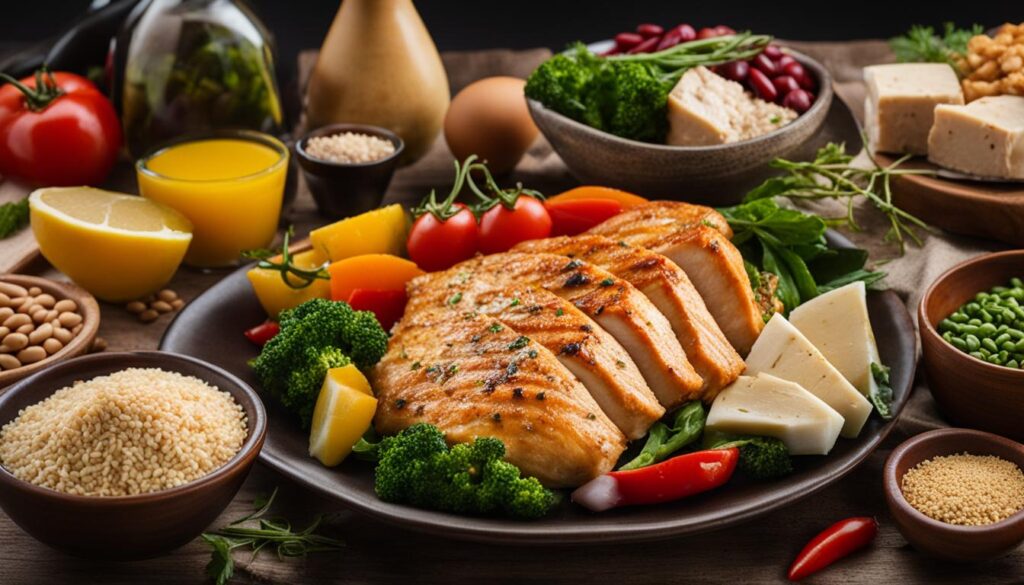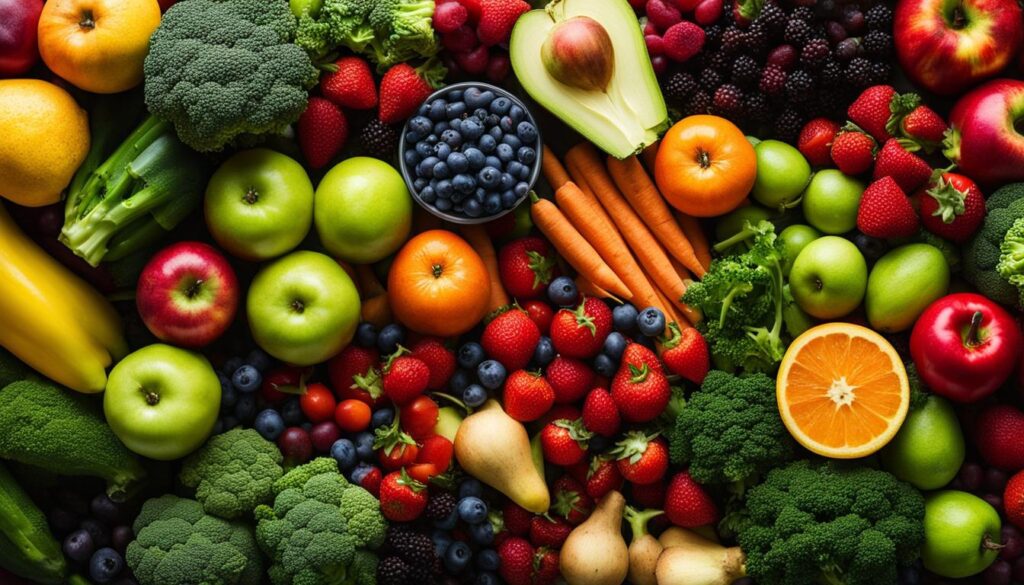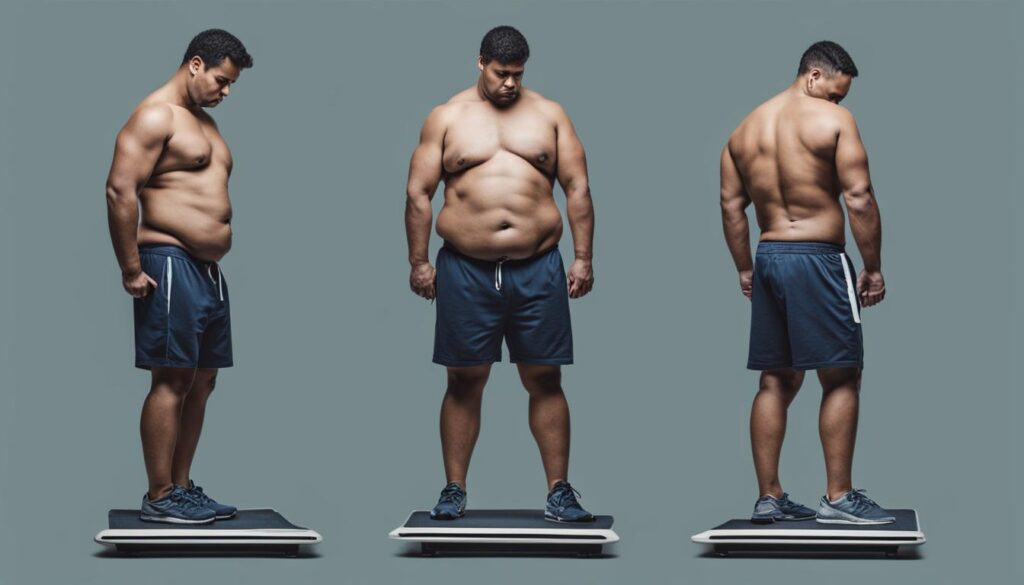Achieving sustainable weight loss can be a challenging journey, especially when faced with stubborn plateaus. But fear not, as I have compiled 14 effective tips to help you break through these roadblocks and continue making progress towards your weight loss goals.
When it comes to weight loss, consistency and perseverance are key. By implementing the following sustainable tips, you can overcome plateaus and maintain your progress on the path to a healthier you.
Key Takeaways:
- Reduce carb intake by following a low-carb diet
- Increase exercise frequency or intensity to boost metabolism
- Track your food intake to identify areas for improvement
- Ensure an adequate protein intake to support muscle preservation
- Manage stress through relaxation techniques
Cut Back on Carbs
When it comes to weight loss, cutting back on carbs can be a game-changer. Research has shown that low-carb diets can be highly effective in promoting weight loss. By reducing your carb intake to 50 grams or fewer per day, you can experience a variety of benefits that help you overcome a weight loss plateau.
Firstly, reducing carb consumption can increase fat burning in your body. When you eat fewer carbs, your body has to rely on stored fats for energy, leading to a higher rate of fat burning. This can help break through the stagnant weight loss phase and kick-start your progress once again.
Additionally, low-carb diets often result in reduced appetite. Carbohydrates are known to stimulate hunger and cravings, making it harder to stick to a calorie deficit. By cutting back on carbs, you may find that your appetite decreases, making it easier to maintain a calorie deficit and continue losing weight.
Tracking and monitoring your carb intake is crucial for success. You can use various apps and websites to track your daily carbohydrate consumption and ensure you stay within the recommended limits. By being mindful of your carb intake, you can optimize your diet and overcome the weight loss plateau.
| Low-Carb Diet Benefits |
|---|
| Increased fat burning |
| Reduced appetite |
| Improved insulin sensitivity |
| Steady blood sugar levels |
| Lower triglyceride levels |
Summary
Cutting back on carbs is an effective strategy for overcoming a weight loss plateau. By reducing your carb intake, you can increase fat burning, reduce appetite, and improve overall metabolic health. Tracking your carbohydrate consumption and staying within recommended limits is crucial for long-term success. Embrace the power of a low-carb diet and push past the plateau towards your weight loss goals.
Increase Exercise Frequency or Intensity
As you progress on your weight loss journey, you may encounter a frustrating hurdle known as a weight loss plateau. This occurs when your body adapts to your current exercise routine and metabolic rate slows down, making it more difficult to shed those extra pounds. Don’t worry, though! There are ways to overcome this plateau and get back on track towards your weight loss goals.
One effective strategy is to increase either the frequency or intensity of your workouts. By doing so, you can boost your metabolism and ignite fat burning, pushing through the plateau and getting closer to your desired weight. There are various types of exercises that can help you achieve this.
Strength Training
Strength training is an excellent way to increase muscle mass, which can rev up your metabolism even at rest. Incorporating weightlifting, resistance band exercises, or bodyweight workouts into your routine can help build lean muscle, burn calories, and break through the weight loss plateau. Aim for at least two to three strength training sessions per week.
Aerobic Exercise
Aerobic exercises, such as jogging, cycling, or swimming, are fantastic for boosting cardiovascular fitness and aiding in weight loss. These exercises increase your heart rate, burn calories, and improve overall endurance. Aim for at least 150 minutes of moderate-intensity aerobic activity each week, or 75 minutes of vigorous-intensity activity.
High-Intensity Interval Training (HIIT)
Another effective workout option for breaking through a weight loss plateau is high-intensity interval training (HIIT). HIIT involves alternating periods of intense, all-out exercise with short recovery periods. This type of workout is known to increase calorie burn, improve cardiovascular fitness, and stimulate fat loss. Aim for two to three HIIT sessions per week.
Remember, when increasing exercise frequency or intensity, it’s essential to listen to your body and gradually progress to avoid injury. Consult with a fitness professional if needed and always warm up before engaging in any vigorous activity.
Incorporating strength training, aerobic exercise, and HIIT into your fitness routine can be a game-changer when it comes to breaking through a weight loss plateau. Stay dedicated, challenge yourself, and watch as the pounds start to melt away.
| Types of Exercise | Recommended Frequency |
|---|---|
| Strength Training | 2-3 sessions per week |
| Aerobic Exercise | 150 minutes/week (moderate-intensity) or 75 minutes/week (vigorous-intensity) |
| HIIT | 2-3 sessions per week |

Track Everything You Eat
When it comes to weight loss, tracking your food intake is a powerful tool that can help you overcome a plateau and take control of your progress. Many people underestimate the amount of food they consume, which can hinder their weight loss journey. By diligently tracking your calorie and macronutrient intake, you can identify any areas where you may be overeating or making poor food choices. This awareness allows you to make necessary adjustments and regain momentum in your weight loss efforts.
Tracking your food intake not only helps you stay accountable but also provides valuable insights into your eating habits. It allows you to identify patterns, pinpoint triggers for overeating, and make informed decisions about your nutrition. Whether you choose to use a smartphone app, a food diary, or a simple spreadsheet, find a method that works best for you and ensures thorough tracking of your meals.
An effective way to track your food intake is to use a digital tool or app that provides a database of nutritional information for a wide range of foods. This allows you to easily input the foods you eat and calculates the calorie and macronutrient content for you. Some popular options include MyFitnessPal, Lose It!, and Fitbit’s food tracking feature.
To make tracking even more effective, consider weighing your food and using accurate portion sizes to ensure precise data. This level of detail can help you identify areas where you may be unknowingly consuming more calories than you realize.
Benefits of Tracking Your Food Intake:
- Increased awareness of portion sizes and calorie intake
- Identifying trigger foods or cravings
- Recognizing hidden sources of excess calories
- Making informed choices to meet your dietary goals
- Monitoring macronutrient balance (carbs, protein, and fat)
- Gaining control over emotional or mindless eating habits
By tracking everything I eat, I was able to identify the sneaky sources of excess calories in my diet. It was an eye-opening experience that allowed me to make the necessary adjustments and break through my weight loss plateau. The numbers don’t lie, and tracking my food intake gave me the power to make informed choices and take charge of my health.
Remember, tracking your food intake is not about restriction or deprivation but rather about gaining knowledge and understanding. It can be a valuable tool to help you make sustainable changes to your eating habits and break through any weight loss plateau you may encounter.
| Food Item | Calories | Carbohydrates | Protein | Fat |
|---|---|---|---|---|
| Oatmeal (1 cup) | 150 | 27g | 6g | 2g |
| Chicken Breast (3 oz) | 130 | 0g | 26g | 3g |
| Broccoli (1 cup) | 55 | 11g | 4g | 0g |
| Avocado (1/2 medium) | 120 | 6g | 1g | 11g |
| Greek Yogurt (1 container) | 100 | 7g | 17g | 0g |
Tracking everything you eat can provide valuable insights into your nutrition and help you make informed choices to support your weight loss goals. By being aware of your calorie and macronutrient intake, you can make necessary adjustments to overcome a plateau and continue your progress.
Don’t Skimp on Protein
When it comes to weight loss, protein is a vital nutrient that should not be overlooked. Increasing your protein intake can have a significant impact on breaking through a weight loss plateau and achieving your desired results.

Protein plays a crucial role in preserving muscle mass, which is essential for overall health and metabolism. As you lose weight, it’s important to maintain muscle to support your weight loss efforts. By consuming an adequate amount of protein, you can prevent muscle loss and even increase muscle mass, which can boost your metabolism and calorie burning.
Moreover, protein has the power to keep you feeling full and satisfied for longer periods. A high-protein diet can help suppress hunger, reduce cravings, and promote satiety, ultimately leading to a lower calorie intake. By increasing your protein intake, you can naturally reduce your appetite, making it easier to control portion sizes and stick to your weight loss plan.
So, how much protein do you need? The recommended daily protein intake varies depending on factors such as age, sex, and activity level. As a general guideline, aim to consume around 0.8 grams of protein per kilogram of body weight. However, if you are engaging in regular intense workouts or strength training, you may benefit from consuming slightly more protein to support muscle recovery and growth.
Good sources of protein include lean meats, poultry, fish, eggs, dairy products, legumes, and tofu. Incorporating a variety of these protein-rich foods into your diet can help ensure that you’re getting all the essential amino acids your body needs.
To summarize, don’t skimp on protein when trying to break through a weight loss plateau. Increasing your protein intake can help preserve muscle mass, boost metabolism, reduce appetite, and prevent muscle loss, all of which are crucial for overcoming a plateau and reaching your weight loss goals.
Manage Stress
Stress is a common and often overlooked factor that can hinder weight loss progress. When you’re stressed, your body releases cortisol, a hormone that can lead to increased appetite, cravings, and emotional eating. This can make it difficult to stick to your weight loss plan and break through a plateau.
To support your weight loss efforts and overcome a plateau, it’s important to prioritize stress management. By incorporating relaxation techniques and deep breathing exercises into your daily routine, you can effectively manage stress and reduce cortisol levels. This will not only help you stay on track with your weight loss goals but also improve your overall well-being.
Techniques for managing stress:
- Practice deep breathing exercises: Deep breathing can help activate the body’s relaxation response and reduce stress. Take slow, deep breaths in through your nose and exhale through your mouth. Repeat this several times whenever you feel stressed or overwhelmed.
- Engage in regular physical activity: Exercise is a powerful stress reliever. Find an activity that you enjoy and make it a regular part of your routine. Whether it’s going for a walk, practicing yoga, or hitting the gym, physical activity can help reduce stress and improve your mood.
- Practice mindfulness meditation: Mindfulness meditation involves focusing your attention on the present moment and accepting it without judgment. This practice can help calm your mind, reduce stress, and enhance your ability to cope with challenges.
- Get enough sleep: Lack of sleep can contribute to increased stress levels. Aim for 7-9 hours of quality sleep each night to help your body and mind recover and reduce stress.
- Engage in stress-relieving activities: Find activities that bring you joy and help relieve stress. Whether it’s reading a book, listening to music, taking a bath, or spending time with loved ones, make time for activities that help you unwind and relax.
“Learning to manage stress is not only beneficial for weight loss but also for overall health and well-being.”
By incorporating stress management techniques into your daily life, you can support your weight loss efforts and overcome plateaus more effectively. Remember, it’s important to prioritize self-care and find healthy ways to cope with stress.
| Stress Management Techniques | Benefits |
|---|---|
| Deep breathing exercises | Activates the body’s relaxation response and reduces stress. |
| Regular physical activity | Relieves stress, improves mood, and promotes overall well-being. |
| Mindfulness meditation | Calms the mind and enhances stress coping abilities. |
| Getting enough sleep | Reduces stress levels and promotes overall health. |
| Engaging in stress-relieving activities | Helps unwind, relax, and reduce stress. |
Try Intermittent Fasting
Intermittent fasting has gained popularity as an effective weight loss strategy. It involves periods of fasting followed by periods of eating. This approach can help create a calorie deficit and improve fat burning, making it useful for breaking through a weight loss plateau.
Intermittent fasting can be done in various ways, such as the 16/8 method, where you fast for 16 hours and restrict your eating window to 8 hours. Another approach is the 5:2 method, where you eat normally for five days and restrict your calorie intake to 500-600 calories for two non-consecutive days.
By incorporating intermittent fasting into your weight loss journey, you can not only overcome a weight loss plateau but also experience other health benefits. Research has shown that intermittent fasting can improve insulin sensitivity, reduce inflammation, and promote cellular repair.
It’s essential to note that intermittent fasting may not be suitable for everyone, especially those with certain medical conditions or a history of disordered eating. Consulting with a healthcare professional before starting any new diet or fasting regimen is always recommended.
To get started with intermittent fasting, consider the following tips:
- Start gradually by extending your fasting period by one to two hours each day.
- Stay hydrated by drinking water, herbal tea, or black coffee during fasting periods.
- Focus on consuming nutrient-dense foods during your eating window to support overall health.
- Listen to your body and adjust your fasting schedule if you experience any negative effects.
Incorporating intermittent fasting into your weight loss journey can provide a fresh approach to overcome plateaus and enhance your progress. Remember to prioritize your health and well-being above all else.
Image: Intermittent fasting can be a helpful strategy for breaking through weight loss plateaus.
Avoid Alcohol
When it comes to weight loss, avoiding alcohol can play a crucial role in breaking through frustrating plateaus. Alcohol provides empty calories, meaning they have little to no nutritional value but still contribute to your total calorie intake. These extra calories can sabotage your weight loss efforts and hinder your progress.
Moreover, consuming alcohol can lead to overeating. It lowers inhibitions and impairs judgment, making it easier to give in to cravings and indulge in unhealthy food choices. Over time, this can result in increased belly fat storage, further hindering your weight loss goals.
To overcome a weight loss plateau and maximize your results, consider reducing or eliminating your alcohol intake. By doing so, you’ll not only eliminate the empty calories from alcohol but also reduce the likelihood of indulging in unhealthy foods.
If you find it challenging to cut back on alcohol completely, start by setting limits and monitoring your intake. Consider alternatives like mocktails or flavored water to satisfy your cravings without sabotaging your progress. Remember, every small step counts.
| Alcoholic Beverage | Calories per Serving |
|---|---|
| Beer (12 oz) | 154-198 |
| Wine (5 oz) | 120-125 |
| Mixed Drinks (8 oz) | 200-300+ |
| Spirits (1.5 oz) | 96-120 |
As you can see from the table above, even moderate alcohol consumption can contribute a significant number of calories to your daily intake. By reducing or eliminating alcohol, you can create a calorie deficit and support your weight loss efforts.
“Cutting back on alcohol was a game-changer for me. Not only did I shed those stubborn pounds, but I also had more energy and felt better overall.” – Jane, Lost 20 lbs
Eat More Fiber
Including more dietary fiber in your diet can have numerous benefits for weight loss, especially if you’ve hit a weight loss plateau. Fiber-rich foods promote feelings of fullness, reduce appetite, and help decrease calorie absorption. One type of fiber, known as soluble fiber, has even been shown to be particularly effective for weight loss.
Soluble fiber forms a gel-like substance in your digestive system, which slows down the digestion and absorption of nutrients. This can help regulate your blood sugar levels, control cravings, and prolong the feeling of fullness, ultimately supporting your weight loss efforts.
To break through a weight loss plateau, it’s recommended to add more fiber-rich foods to your daily meals and snacks. Fruits, vegetables, and whole grains are excellent sources of dietary fiber and can easily be incorporated into a balanced diet. Here are some examples of high-fiber foods:
- Apples
- Berries
- Broccoli
- Brussels sprouts
- Chia seeds
- Flaxseeds
- Oats
- Quinoa
- Sweet potatoes
By including these fiber-rich foods in your meals, you can not only enhance your overall health but also give your weight loss journey a much-needed boost.

Benefits of Dietary Fiber for Weight Loss
Dietary fiber offers several key benefits when it comes to weight loss:
- Increased satiety: Foods high in fiber take longer to chew and digest, helping you feel more satisfied and less likely to overeat.
- Reduced appetite: Soluble fiber absorbs water and forms a gel-like substance, which can help reduce hunger and cravings.
- Lower calorie absorption: Fiber binds to some of the calories in the food you eat, reducing the overall calorie absorption by your body.
- Improved gut health: Fiber acts as a prebiotic, feeding the beneficial bacteria in your gut and promoting a healthy gut microbiome, which is important for weight management.
By incorporating fiber-rich foods into your diet, you can overcome a weight loss plateau and continue making progress towards your goals.
Being Mentally Prepared
Before embarking on your weight loss journey, it’s crucial to assess your mental and emotional readiness. This plays a significant role in overcoming a weight loss plateau and achieving long-term success. Here are some key factors to consider:
- Set Realistic Goals: Establishing achievable weight loss goals is essential. When setting goals, aim for gradual and sustainable progress rather than unrealistic expectations. This approach helps you stay motivated and prevents disappointment when facing plateaus along the way.
- Understand Your Motivations: Take the time to reflect on why you want to lose weight. Are you motivated by health concerns, increased confidence, or a desire for a more active lifestyle? Understanding your underlying motivations can help you stay focused and committed during challenging times.
- Be Prepared for Lifestyle Changes: Weight loss involves making significant changes to your daily habits and routines. These changes may include modifying your diet, increasing physical activity, and prioritizing self-care. Being mentally prepared and adaptable to these adjustments sets the stage for long-term success.
Remember, weight loss is not only a physical journey but also an emotional one. Embracing a positive mindset, practicing self-compassion, and seeking support from friends, family, or a healthcare professional can further enhance your mental readiness for the challenges ahead.
Set Realistic Weight Loss Goals
When it comes to achieving long-term success in weight loss, setting realistic and achievable goals is crucial. While it’s natural to have high aspirations, aiming for overly ambitious targets can often lead to disappointment and frustration, especially when facing a weight loss plateau.
To ensure continued motivation and progress, it’s important to focus on creating small, attainable goals that can be accomplished within a reasonable timeframe. These realistic goals not only keep you on track but also boost your confidence as you achieve each milestone.
“Setting realistic goals is the first step in turning the invisible into the visible.” – Tony Robbins
When setting your weight loss goals, consider factors such as your current weight, health condition, and lifestyle. Consult with a healthcare professional or a certified nutritionist who can provide guidance based on your individual needs and circumstances.
Here’s an example of how you can set realistic weight loss goals:
| Goal | Timeline |
|---|---|
| Lose 1-2 pounds per week | 3 months |
| Incorporate strength training twice a week | 1 month |
| Reduce added sugar intake by half | 2 weeks |
| Drink at least 8 glasses of water daily | Ongoing |
As you can see, these goals are specific, measurable, attainable, relevant, and time-bound (SMART). They provide a clear direction, making it easier to track your progress and make necessary adjustments along the way.
Remember, weight loss is a journey, and reaching your goals takes time and effort. By setting realistic expectations and celebrating your achievements along the way, you’ll stay motivated, overcome plateaus, and achieve sustainable weight loss.

Conclusion
In conclusion, sustainable weight loss requires a combination of patience, consistency, and making necessary adjustments. By following the tips mentioned in this article, such as cutting back on carbs, increasing exercise frequency, tracking food intake, managing stress, and setting realistic goals, you can overcome stubborn weight loss plateaus and achieve long-term success.
Reducing carb intake can boost fat burning and reduce appetite, while increasing exercise frequency or intensity can help boost metabolism. Tracking your food intake allows you to identify areas where you may be overeating and make necessary adjustments. Managing stress is crucial for preventing emotional eating, and setting realistic goals helps to maintain motivation.
By implementing these strategies, you can break through weight loss plateaus and achieve sustainable weight loss. Remember that everyone’s weight loss journey is unique, and it’s important to listen to your body and make adjustments as needed. Stay consistent, stay committed, and you will see the results you desire.
FAQ
Is cutting back on carbs effective for breaking through a weight loss plateau?
Yes, reducing your carb intake to 50 grams or fewer per day can increase fat burning and reduce appetite, helping you overcome a weight loss plateau.
How can I increase exercise frequency or intensity to break through a weight loss plateau?
To boost your metabolism and continue your weight loss progress, try incorporating strength training, aerobic exercise, and high-intensity interval training into your routine.
How can tracking everything I eat help me overcome a weight loss plateau?
By tracking your calorie and macronutrient intake, you can identify any areas where you may be overeating or making poor food choices, allowing you to make necessary adjustments to break through a plateau.
Why is protein important for breaking through a weight loss plateau?
Increasing your protein intake can help reduce appetite, increase calorie burning, and preserve muscle mass during weight loss, making it useful for overcoming a stubborn plateau.
How can I manage stress to support my weight loss efforts?
Learning stress management techniques like relaxation exercises and deep breathing can help reduce cortisol levels and prevent emotional eating, supporting your weight loss journey and helping you overcome a plateau.
Is intermittent fasting an effective strategy for breaking through a weight loss plateau?
Yes, intermittent fasting involves periods of fasting followed by periods of eating and can create a calorie deficit and improve fat burning, making it beneficial for breaking through a weight loss plateau.
Should I reduce or eliminate alcohol consumption to overcome a weight loss plateau?
Yes, alcohol provides empty calories, promotes overeating, and increases belly fat storage. By reducing or eliminating alcohol intake, you can support your weight loss efforts and overcome a plateau.
How does eating more fiber help break through a weight loss plateau?
Including fiber-rich foods in your diet can promote feelings of fullness, reduce appetite, and decrease calorie absorption. Soluble fiber, in particular, has been shown to be effective for weight loss.
How important is mental readiness when it comes to weight loss?
Assessing your mental and emotional readiness before starting your weight loss journey is crucial for long-term success. Setting realistic goals, understanding your motivations, and being prepared to make lifestyle changes are key factors in overcoming a weight loss plateau.
Why is it important to set realistic weight loss goals?
Setting realistic and achievable weight loss goals is crucial for long-term success. Avoid setting overly ambitious targets and focus on creating small, attainable goals that can be accomplished in a reasonable timeframe. This helps maintain motivation and prevents disappointment when facing a plateau.
How can I break through a weight loss plateau?
Overcoming a weight loss plateau requires patience, consistency, and a willingness to make necessary adjustments. By implementing the tips mentioned in this article, such as cutting back on carbs, increasing exercise frequency, tracking food intake, managing stress, and setting realistic goals, you can break through stubborn weight loss plateaus and achieve sustainable long-term weight loss.


[…] you have quick and easy options throughout the week. By incorporating effective time management tips and sustainable practices, meal prep becomes a convenient solution for busy […]